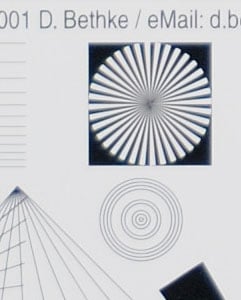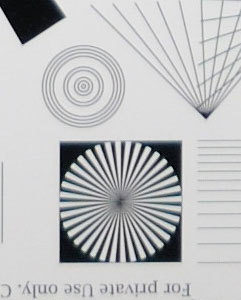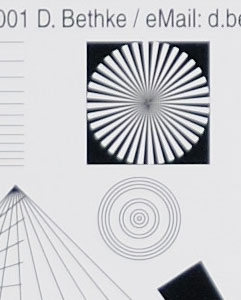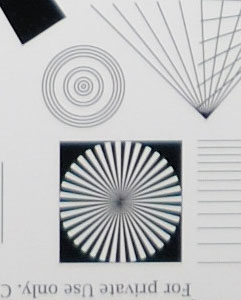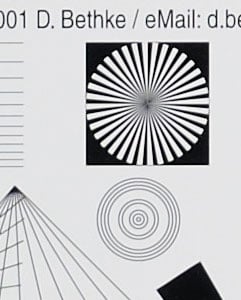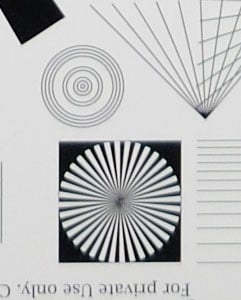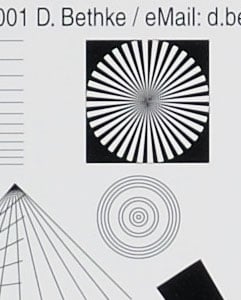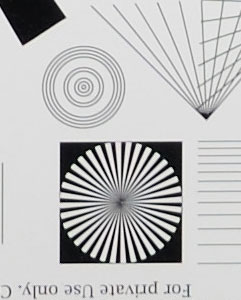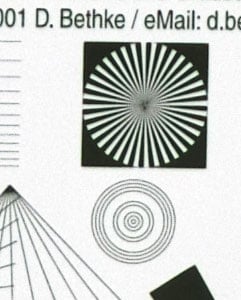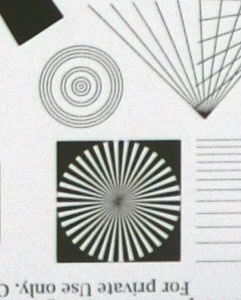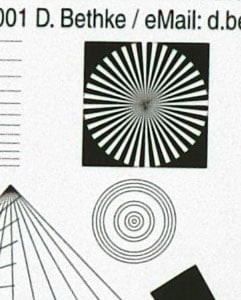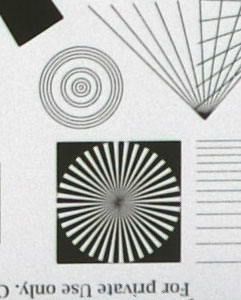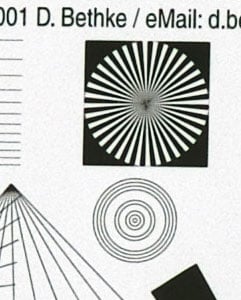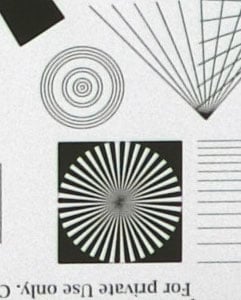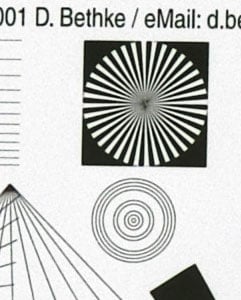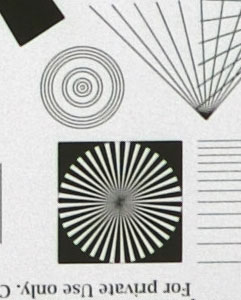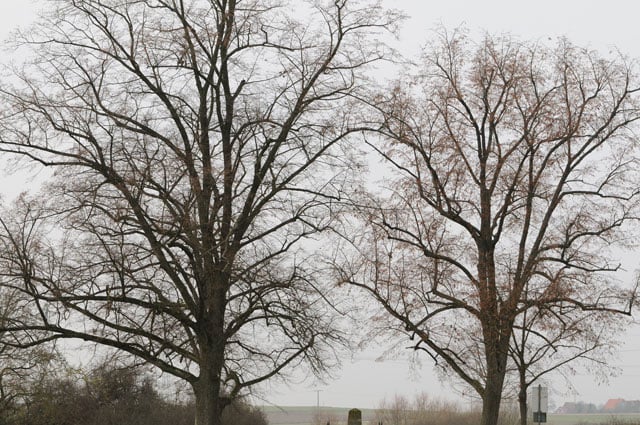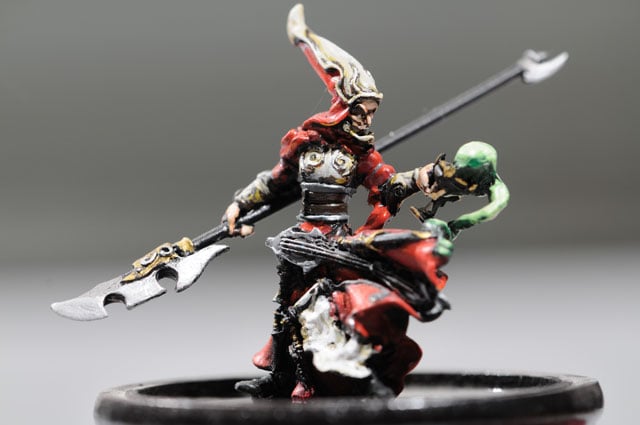Nikon DX Micro 85mm f3.5G VR review
-
-
Written by Thomas
Quality
Facts from the catalog
Let’s have a look at the technical data. I’ve rated the features with a [+] (or [++]) when it’s better than average or even state of the art, a [0] if it’s standard or just average, and [-] if there’s a disadvantage.
Size and weight: 73x99mm at 355g = relatively slim but relatively long (140mm including lens-hood), so people may start looking if you point it at them. The weight is nothing to worry about but it’s clearly heavier than the 235g of the 40/2.8G. The lens is still “pocketable” if you take the pocket of an overcoat. With its larger cousin, the VR Micro-Nikkor 105/2.8G, you wouldn’t normally do such a thing as this weighs 750g! [0]
Optics: 14 elements in 10 groups which is double the number of the DX Micro-Nikkor 40/2.8G. I was quite surprised to see such a complex design including one ED-element (but no nano-coating). Complex designs with many glass/air surfaces tend to produce somewhat lower contrast and increase the risk of flare/glare or ghosts. Overall the design is pretty similar to the VR Micro-Nikkor 105/2.8G (which has nano-coating), even from the outside both lenses share a similar look. [0]
| Nikon Micro Nikkor cross-section | ||||
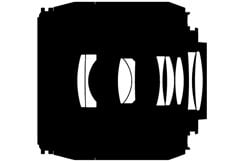 | 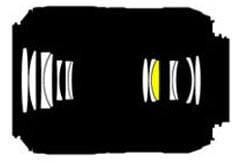 | 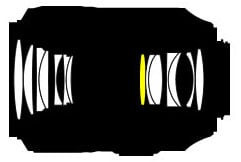 | ||
DX Micro-Nikkor 40mm f/2.8G | DX Micro-Nikkor 85mm f/3.5G VR | VR Micro-Nikkor 105mm f/2.8G | ||
| The three Micro-Nikkors |
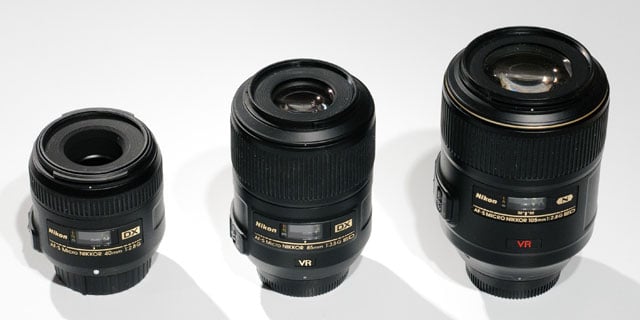 |
| Form left to right: 40/2.8G, 85/3.5G VR, 105/2.8G VR |
Closest focus distance/max. magnification: 0.29m / 1:1. Magnification of 1:1 is standard with Nikon’s Micro-Nikkors, but other manufacturers call some of their lenses “macro” while only reaching 1:4 magnification. So this is a clear [+] for the Nikkor. But the other important thing with magnification is the working distance from the front lens at 1:1, a figure that is rarely published in the technical data. I measured a working distance from the front of the lens (w/o hood) of 14cm. This is much better than with it’s shorter cousin, the 40/2.8G, which only leaves you with 3cm (!) of room. Still you might find that 14cm is too close for the comfort of many small critters. [0]
Filter-thread: 52mm = same as the 50/1.8D, DX 35/1.8G, and 40/2.8G. The small size makes filters cheaper. [+]
Image stabilization: Yes = a real bonus! This lens is the shortest Nikkor prime lens with stabilization. And at an equivalent focal length of 128mm and the small pixel-pitch of say a D5100 you would need to go at least for 1/125 sec if you wanted to avoid blur w/o stabilization. So with VR you can expect to be on the safe side at 1/30 sec or even 1/15 sec. [+]
Auto focus: AF-S with SWM (silent wave motor), so it’ll work on any Nikon DSLR while also offering manual-focus override by turning the focus ring. The focus scale has a third line that shows magnification in addition to the shooting distances in m and ft. [+]
Covers only DX-sized sensors = you have to upgrade your lens (or shoot in DX-mode) should you get an FX body. [-]
Comes with a flexible lens pouch, snap-on front lens cap, rear lens cap, and revertible bayonet hood, like any standard Nikon lens. [0]
Price: around 440 EUR new (incl. 19% VAT) = not as cheap as the 40/2.8G. For this price you can buy the 40/2.8G macro lens plus a 50/1.8G or 35/1.8G and get some spare change! But it is still almost 300 EUR cheaper than the 105/2.8G. [0]
Distance information is relayed to the camera, so the Nikon body can do all the advanced exposure-related stuff with this lens. But this is true for all the alternatives too. [0]
Aperture ring = no, just like all Nikon G-lenses. [0]
Sealing: yes! There’s a rubber grommet on the lens-mount. [+]
Focus limiter switch: No. So AF has always to consider the whole range of possible subject distances. This could result in focus hunting. [0]
This gives a total score of 1[-] / 8[0] / 5[+] in the “features-department”. That is not bad but looks more like a “middle-of-the-road” design. The DX image-circle is the only really limiting factor that you need to take into account when you consider buying this lens.
Motivation
:
A 85mm macro-lens is for getting close to your subject and showing details other lenses can’t show. And it also doubles up as a moderate tele-lens. Plus there are expectations that macro-lenses are pretty sharp. But you have to wait just a little bit to see whether the lens fulfills this expectation.
Alternatives
:
– The Nikon AF-S Micro-Nikkor 60mm f/2.8G ED or the Sigma AF 70mm f/2.8 EX DG Macro. Shorter, no stabilization, larger aperture, slightly more expensive, cover FX-sensors.
– The Tamron SP AF 60mm 2.0 Di II LD IF Macro. Shorter, no stabilization, large f/2.0 aperture, at 340 EUR clearly cheaper, covers FX-sensors.
– The Tamron SP AF 90mm 2.8 Di Macro for 380 EUR or the Sigma AF 105mm 2.8 EX DG Macro for 550 EUR.
– The stabilized 105mm f/2.8 macro-lenses from Nikon and Sigma are not really in the same price-bracket as you need to invest at least 730 EUR.
So if you’re willing to forego image stabilization there are many alternative lenses to choose from at similar prices.But if you prefer image stabilization the DX Micro-Nikkor 85mm f/3.5G VR is the cheapest way to go!
Testing: Longitudinal Chromatic Aberration
Axial color (longitudinal CA, loCA) is a very common problem with large aperture primes and is not as easy to correct in post processing (or in-camera) as lateral CAs. Longitudinal CAs create some greenish tint with background subjects and a magenta tint on foreground subjects. As the 85/3.5G has a pretty moderate max aperture you’d expect this lens not to be effected by this problem. This is indeed the case.
Below left is the result for the 85/3.5G showing a 100% crop at f3.5. The loCA effect is pretty weak and almost completely gone by stopping down to f5.6. Processing was done in Capture NX 2 with standard settings meaning lateral CA removal was ON, loCA removal = OFF. Below right you see the results from setting loCA removal to 50% in Capture NX.
Nikon AF-S DX Micro-Nikkor 85mm f/3.5G ED VR Longitudinal Chromatic Aberration (loCA) | ||
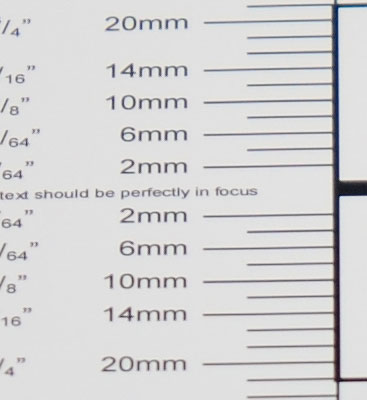 | 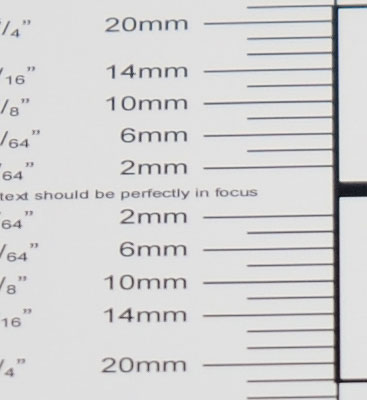 | |
| 100% crop, f3.5, loCA removal OFF in Capture NX2 | 100% crop, f3.5, loCA removal 50% in Capture NX2 | |
Sharpness and contrast
Let’s have a look at the theoretical performance (MTF-charts) of the new lens before analyzing the results from the test-shots:
| Nikon Micro-Nikkor MTF | ||||
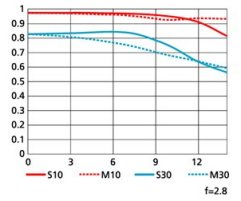 | 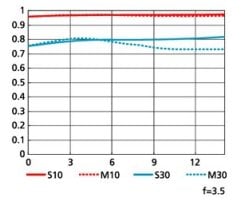 | 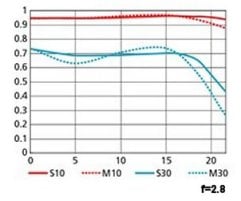 | ||
DX Micro-Nikkor 40mm f/2.8G | DX Micro-Nikkor 85mm f/3.5G VR | VR Micro-Nikkor 105mm f/2.8G | ||
These charts show the lens-performance at the largest aperture. To read these charts you only have to understand that higher values are better and that the closer the dotted and the continuous lines are together the less astigmatism (= resolution depends on the orientation of the test-pattern) the lens displays. The DX-corners where I measure with the D300 are approximately at 12mm on the X-axis.
From the charts the new lens should perform very good with very high contrast over the complete image-field and some impressive sharpness that does not deteriorate towards the corners. But to really understand what this lens can produce we need to look at real test-shots with a challenging target, the Siemens-stars, with different apertures and different shooting distances. Because performing well at larger magnifications is no easy feat – otherwise people would be only buying extension tubes.
This comparison comes in 2 parts: center- and corner-performance at normal distances (around 3m, 1:35 magnification), followed by center- and corner-performance at macro distances (around 40cm, 1:2.6 magnification).
Processing was done in CaptureNX2 at standard settings, with white-balance adjusted to a neutral white and some exposure compensation to make the brightness match. CA-removal is ON. Focus was achieved as usual in live-view with a little optimization by hand and was performaned separately for the center and the corners to avoid any effect from field curvature.
These are all 100% crops!
| Part 1: Center- and corner-performance at standard (1:35) magnification (around 3m) Shot from a printed test-target
Part 2: Center- and corner-performance at around 1:2.6 magnification (around 40cm)
|
At larger magnifications the center of this lens is pretty good straight from the largest aperture, which is f4.0 at a magnification of 1:2.6. The corner is also quite good already. Stopping down to f5.6 or f8 produces even sharper and more contrasty results – as was to be expected. Overall the performance for shooting close-up is very good and as you normally have to close the aperture a bit to get a sufficiently large depth-of-field at magnifications larger than 1:3 you could indeed enjoy very sharp macro-shots with the 85mm. Again if you’d like to compare the quality of this lens to the Nikon DX Micro-Nikkor 40mm f/2.8G and the Nikon AF-S VR Micro-Nikkor 105mm f/2.8G IF-ED, see my Nikon Micro-Nikkor lens comparison.
Nikon 85mm Micro-Nikkor sample images gallery
The following images were taken with the Micro-Nikkor 85mm f/3.5G ED VR. Each image was recorded in RAW and converted with Capture NX 2 at standard settings. Some images have White Balance set to a standard daylight value to make them comparable. No extra sharpening, tone, color or saturation adjustment was used.
The first shots show the performance at/near infinity on a D300. This is important for all landscape shooters. The three 100%-crops are taken from the middle of the f3.5, f4.0, and f5.6 version of each image while the main image shows the shot at f8.0. You can click on each image to access the large original. These files are for personal evaluation only and cannot be used in another publication or website without permission.
| Trees: infinity shot with Nikon AF-S DX Micro-Nikkor 85mm f/3.5G ED VR on a D300 | ||||
| f8.0, 200 ISO | ||||
 |  |  | ||
f3.5, 200 ISO | f4.0, 200 ISO | f5.6, 200 ISO | ||
The next row shows 100%-crops from the right border.
| Trees: border performance with Nikon AF-S DX Micro-Nikkor 85mm f/3.5G ED VR on a D300 | ||||
 |  |  | ||
f3.5, 200 ISO | f4.0, 200 ISO | f5.6, 200 ISO | ||
These images show that the lens delivers good performance with a touch of haziness in the center at f3.5. Stopping down to f4.0 improves the center performance visibly. From f5.6 on the performance is very good and the light fall-off in the corners is considerably reduced but still it can’t match the crispness and detail of the DX Micro-Nikkor 40mm f/2.8G.
The next shot should give you an impression of the close-up performance that this lens can deliver. Magnification is around 1:2.5 and I’ve chosen f8.0 here to get a decent depth-of-field. Clicking on the image gives you access to the large original. The three small crops below are displayed at 100%. When you compare these crops to the same shots from my Nikon 40mm Micro-Nikkor review, please allow for small focus variations. This real-life test confirms what we’ve already seen from the test-charts: This lens is a very good performer under close-up conditions. And one thing is pretty obvious: The isolation of the figure from the background is much better with this lens than with its shorter cousin, the 40/2.8G, although the shots have the same magnification and use the same aperture – so technical depth-of-field is identical across these shots.
| Wizard: close-up shot with Nikon AF-S DX Micro-Nikkor 85mm f/3.5G ED VR on a D300 | ||||
| f8.0, 200 ISO | ||||
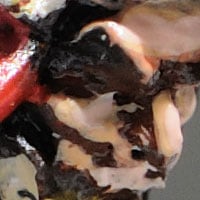 | 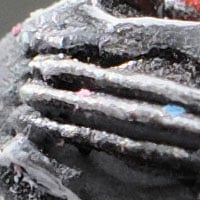 | 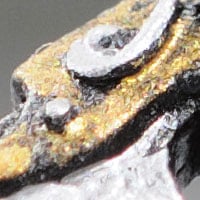 | ||
f8.0, 200 ISO | f8.0, 200 ISO | f8.0, 200 ISO | ||
Focus and build quality
Focus accuracy and repeatability is critical for people relying on AF. Repeatability (=accuracy of focus on the same subject after repeated focus-acquisition) is very good with no real outliers over a series of 14 shots. The slight focus-variations that you can observe seem to be dependent on the direction the focus was coming from (infinity or minimum focus distance). The 85/3.5G focuses pretty fast: around 0.8 sec from minimum focus distance (MFD) to infinity. But under some conditions it tends to hunt in the wrong direction (namely close-up) first. As there is no focus limiter switch the lens may have to focus through its entire range before acquiring the subject, wasting valuable time. The focus ring of the 85/3.5G turns about 170° from infinity to MFD. This throw is good enough for manual focusing (in live-view) and fortunately there is none of the play between the focus-ring and the focus-action I found on the cheaper 40/2.8G. The AF-operation is very quiet and the focus-ring operates very smoothly. This all supports the general impression of solid build quality that this lens conveys: plastic construction with a metal lens-mount, nine rounded aperture blades, and a tightly fitting lens-shade. If you shake the lens there is some noise to be heard, but that is normal with a stabilized model.
Two things happen when you focus towards the MFD: The effective maximum aperture shrinks to f5.0 (f4.2 at a magnification of 1:2), and the smallest aperture goes from f32 to f45. But the physical length of this lens does not change. The shrinking of the effective aperture is nothing to lament about, with a non-IF design those values would be f7.0 resp. f64 at 1:1 magnification.
One final remark regarding focus with this lens: It required a value of -10..-15 for AF fine-tuning on my D300 body to give the best results. This is one of the highest AF tuning values I had to dial in for a Nikon lens. The 40/2.8G for example needed no AF tuning at all. This of course can vary from camera to camera and even from lens to lens, so it is not a general problem. But with bodies that don’t allow for AF tuning this might pose a barrier to achieving the most accurate AF.
Image stabilization
It’s always good to see Nikon’s VR (vibration reduction) in a lens. This is a clever way to reduce shake when shooting free-hand (that is unless Nikon would build a body with sensor-based image-stabilization). Nikon has proven time and again that their VR is quite effective although as a pixel-peeper I would not necessarily rely on more than a 2-stop reduction in shutter-speed. And I was not surprised to find the VR work as advertised at normal distances.
But the real question is what can VR do for you when shooting up-close. There is some debate whether image-stabilization still is effective when you come closer to 1:1 magnification. That was something I wanted to find out. So I did two series of shots at around 1:2 magnification: one with VR=ON and one with VR=OFF. And then I added another series of shots with the non-stabilized DX Micro-Nikkor 40mm f/2.8G to see how it compared. I was standing a little stooped in front of the target which is not the ideal position for slow shutter-speeds and did 10 shots each in intervals of one second. After downloading the images to my computer I looked through the series at increasing magnification and awarded additional stars for those shots that still looked sharp at the respective magnification. So I ended up with a statistic of how many shots with the 85/3.5G with VR=ON were zero stars, one star, two stars, etc. and could compare these results across the different series. As this is quite a chore I tested only at a speed of 1/15 sec. This is a pretty slow speed and is far beyond the recommended formula of using 1/focal length as shutter-speed for sharp hand-held images. If the image-stabilization can hold a two stops longer shutter-speed that would mean around 1/20 sec for the 85mm lens.
When looking at my statistics I found out:
1. With VR=OFF the 85mm lens produces results that were on average only half as good as from the 40mm macro-lens.
2. With VR=ON the 85mm was scoring about 3x better than with VR=OFF and 50% better than the 40mm.
So in the end the VR makes the longer 85mm lens produce sharper results than its shorter cousin in a handheld environment. That looks like an almost two-stop advantage to me and proves that VR is clearly beneficial also for macro-shots, at least when handheld. A word of warning though: even with VR=ON there were only half of the shots sharp enough at 1/15 sec. So you better get a tripod or use speeds of 1/30 sec or 1/60 sec to avoid blurring a macro-shot.
All-in-all the AF-S DX Micro-Nikkor 85mm f/3.5G ED VR delivers a pretty good performance, so let’s wrap things up in my Nikon 85mm macro lens verdict.
